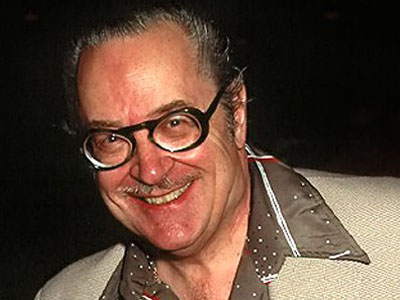
Forrest J Ackerman died late last night, two minutes before the Witching Hour. Though the science-fiction community has been on Deathwatch for years now, it's still in a way surprising.
Forry, as everyone called him, was a unique individual — an editor, writer, agent, occasional actor and a big historian of science-fiction and monster movies. More accurately, he was a professional fan. Born November 24, 1916, he began collecting fantasy magazines and pulps at age 10 and was present and quite involved in the founding of what we now call science-fiction fandom. Many people cite The Time Traveller, a mimeographed newsletter published in 1932 by future comic book editors Mort Weisinger and Julius Schwartz as the first s-f "fanzine." That first issue featured an article by a teenage Forrest J Ackerman.
The first known American s-f fan convention was held in New York in 1939 and Forry was present. He continued to write or agent work in the genre — and supposedly coined the slang term, "sci-fi" — but he came into his own in 1958 with the founding of Famous Monsters of Filmland. Published by James Warren, the bizarre magazine drew on Ackerman's by-then extensive collection of photos and his connections within the world of science-fiction and horror films…but Ackerman was more than its editor. He was to Famous Monsters what Hugh Hefner was to Playboy — a spokesperson and figurehead, around whose life the entire publication was fashioned.
His enthusiasm for the material gave the magazine a flavor that its many imitators couldn't match. They could print the same stills, interview most of the same interviewees…but they lacked the Secret Ingredient, which was Ackerman. He was as much a star of the publication as Bela Lugosi, loading each issue with monster puns and jokes to the delight of a young and loyal male demographic. Many who grew up on it still refer to him as Uncle Forry, including no small number who became authors or filmmakers and credit the influence of Ackerman.
Famous Monsters lasted until 1983, though Forry left it before then when declining sales made it no longer worth his time. It helped him grow his fame and his amazing collection but it was never his main source of income. That came from agenting, writing and editing other materials, mainly of a science-fiction nature. He was briefly involved in a revival of the magazine in the nineties but that relationship ended in a loud and bitter lawsuit.
I first met Forry when I paid the first of what turned out to be several visits to his fabled "Ackermansion" — his home, though portions of it resembled a museum of science-fiction and horror. This was in the late sixties when he still resided on Sherbourne Drive in Beverly Hills…in what was a playground for anyone interested in macabre books and movies. My interests in those areas were never as fervent as some but still, to me and everyone, Forry was a great host, always available to answer questions or discuss fannish pursuits. Later, the Ackermansion relocated to a nicer home in Los Feliz and I visited there a few times, somehow regretting the classier surroundings.
Forry had his detractors — in some cases because of the image he put forth of science-fiction fandom; in other cases, due to various business-type relationships. I have no interest in getting involved in those arguments, especially now when his friends and admirers are in mourning. Some are probably in shock, as Forry always seemed immortal in some death-mocking manner.
For at least the last ten years, we've been hearing that he would pass "any day now," and somehow — I don't know how he did it but vampirism has been suggested — he seemed to keep showing up at the Comic-Con International and other conventions. For the last month or two, various websites have prematurely reported his death, and I'm told this greatly amused him. This time, I'm afraid, it's for real.
Those close to Forry saw him through some rocky times, including the sale of most of the famed Ackerman collection. He had long hoped some deep-pocketed institution would purchase it from him and establish a serious Museum of Science-Fiction and Horror but he eventually came to realize that was not going to happen. Items were sold off when he started to need cash, in part to finance the above-mentioned lawsuit, which he won big but never collected on.
Still, he seemed revitalized by that victory. His last few years, when he wasn't in a hospital, one could find him in a small apartment not far from where the Los Feliz Ackermansion had been located. As health permitted, he was available to any fan who wished to drop by, look at some remnants of the collection and hear the usual Ackerman anecdotes. My pal Scott Shaw! once proposed that after Forry died, we have him stuffed and then someone could take him to conventions and put him on display, with a tape recorder endlessly replaying the dozen-or-so stories we heard him tell again and again. I still don't think that's a bad idea…and from what I could tell, Forry didn't seem to think it was all that bad an idea, either.